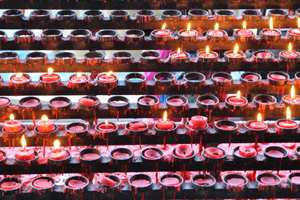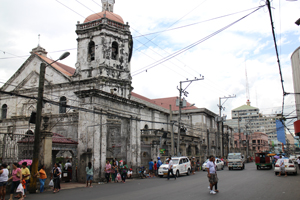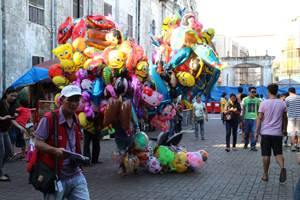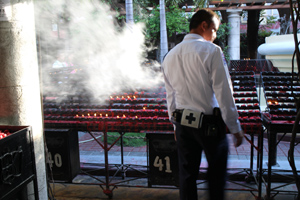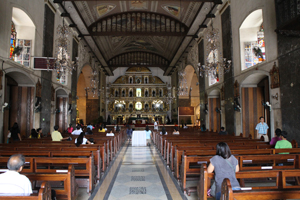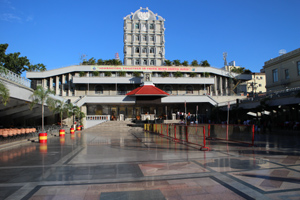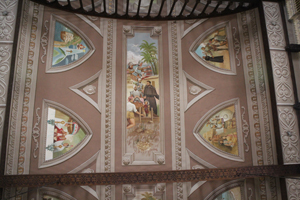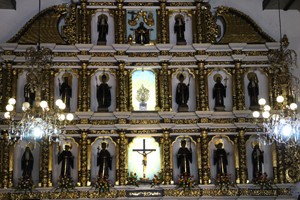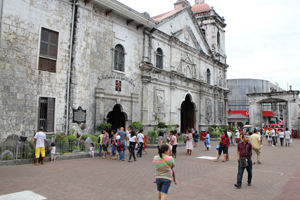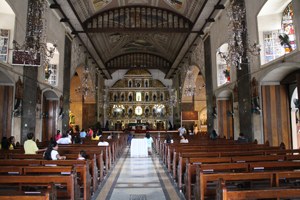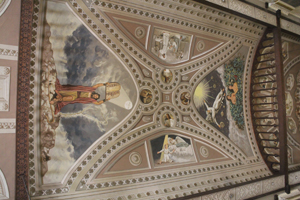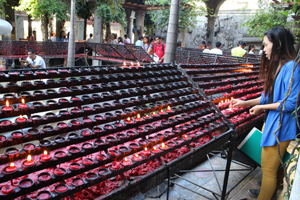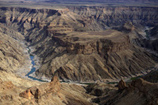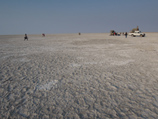Got Photographs of the Santo Niņo that you want to share? send them to us Email: bookphilippines@madbookings.com
Devotion to Sto. Niño
The Chapter held on August 6, 1578 recommended to all the fathers
"that prayers to the Sto. Niño be offered every month as was
the custom before." In 1641, the father provincial ordered that the
feast of the Sto Niño be celebrated on January 14 “with all
the possible solemnity, mass and sermon, since He deserves all the affection
from us, being the Dulcisimo and most affectionate patron of our province."
Fr. Nicolas de la Cuadra (1731) was very instrumental in spreading the devotion of the Sto. Niño. He led an exemplary life, had writings and solemn rites which he established in the sanctuary, and acquired many jewels for the decoration of the statue.
The first novena to the Santo Niño was introduced by Fr. Mateo Diez, rector of the sanctuary in 1889, under the Cebuano title Novena ug pagdayeg sa Sto. Niño Jesus nga guisimba sa cyudad sa Sugbu , printed in Mandaluyong, Asilo de Huerfanos , 1888. This novena has been reprinted countless times.
Up to this time, the number of Sto. Niño devotees who follow the novena and attend mass every Friday keeps on increasing.
Construction of the Church
1566 - the first church believed to be built on the site where
the image of the Holy Child was found was destroyed by fire. It was said
to be built by Fr. Diego de Herrera using wood and nipa.
1605 - Fr. Pedro Torres started the construction of a new church, again
made of wood and nipa. It was finished in 1626 but was again burned in
1628.
1628 - Fr. Juan Medina started the construction of another church, using
stone and bricks, a great innovation at that time. The construction was
stopped because the structure was found to be defective - the bricks used
seemingly "melted" upon contact with air.
February 29, 1735 - Father Provincial Bergaño, Governor-General
Fernando Valdes, Bishop Manuel Antonio Decio y Ocampo of Cebu and Juan
de Albarran Prior of the Santo Niño, started the foundations of
the present church, using stone. A lot of help came. Fr. Antonio Lopez,
prior of San Nicolas, assisted also together with the people of his district.
The residents of Talisay also did four weeks of work and Fr. Francisco
Aballe also tried to help with his parishioners from Mactan.
The materials used:
The stones were quarried from Capiz and Panay by an army of bancas.
The molave wood came from the mountains of Talisay and Pitalo and was
transported in bancas hired in Argao and Carcar. Fr. Albarran confessed
that there was much difficulty in quarrying the stones. Despite the seemingly
impossible task, Fr. Albarran was not discouraged. He used white stones
to make the lime, with one banca transporting some 400 pieces of stones.
There was also another obstacle: the lack of chief craftsmen and officers
which forced Fr. Albarran to acquire some knowledge of architecture.
The church was finished not later than 1739. According to an author named Vela, "the church has all the characteristics of a solid construction to withstand all the earthquakes..." And true enough, the church withstood all earthquakes.
The original features of the church have been retained except for the windows added by Fr. Diez in 1889. In 1965, both church and convent underwent a bigger restoration on the occasion of the fourth centennial of the Christianization of the country. The face lifting was made with utmost respect for the historical character of the old structure.
Cardinal Hildebrando Antoniutti, Papal Legate to the Philippines , conferred upon the church the title of Basilica minore , a special privilege granted to the Augustinian Order by the Pope Paul VI. On the other hand, the former President Ferdinand Marcos declared the Sto. Niño Basilica a national shrine because of its historical significance.
Style of the Church
Facade - a blending of Muslim, Romanesque and neo-classical features
- all set in what has otherwise been described as a high degree of integration.
The façade is preserved in its original stone texture and natural
color, conveying an air of simplicity of line and elegance.
Bell tower - serves as a counterbalance to the convent located on the
opposite far end. It has two blind and open windows alternating in shape,
ending up in triangular pinnacles with a circular disc crowned by balusters
and a bulbous dome of Muslim influence.
Center section - the focus of attention. The arched main entrance is balanced
by the side rectangular corners. A double-edged triangular pediment crowns
the facade.
The Sinulog
Cebu is abuzz with a flurry of activities every January of each
year which culminates on the third Sunday, during which the fiesta Señor
takes place.
On said Sunday, the grandest and biggest of all Philippines festival takes place in the streets of Cebu, the Sinulog Festival. The Sinulog takes its roots from the candle vendors in front of the Augustinian Church of Cebu. It is rendition of the sinug, which is a prayer-dance offered either in supplication or in thanksgiving to the Santo Niño. It is by candle-waving women who follow a simple forward and backward routine while offering prayers for any devotee.
The dance routine of the sinug is said to be in imitation of the sulog (current) of Pahina river of Cebu City. While dancing and waving candles, the women chant: Pit Señor! Pit Señor! which is short for Sangpit sa Senyor or loosely translated as Hail the Lord! Devotees have also adopted the chant as an ejaculatory prayer and one would normally hear petitions like: Pit Senyor kang Tatay kini (Hail the Lord, this one's for my father!)
On the third Sunday of each year, countless visitors from outside Cebu the Philippines come to Cebu City to witness the Sinulog Festival where performers from various parts of the archipelago congregate in supplication or in thanksgiving for the blessings received from the Holy Child.
